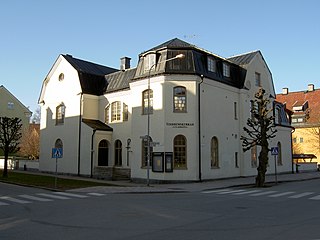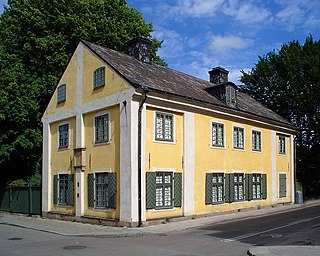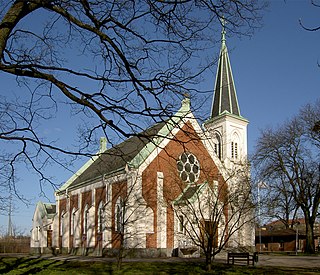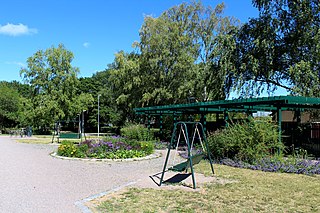Self-guided Sightseeing Tour #6 in Uppsala, Sweden
Legend
Guided Free Walking Tours
Book free guided walking tours in Uppsala.
Guided Sightseeing Tours
Book guided sightseeing tours and activities in Uppsala.
Tour Facts
5.1 km
58 m
Experience Uppsala in Sweden in a whole new way with our free self-guided sightseeing tour. This site not only offers you practical information and insider tips, but also a rich variety of activities and sights you shouldn't miss. Whether you love art and culture, want to explore historical sites or simply want to experience the vibrant atmosphere of a lively city - you'll find everything you need for your personal adventure here.
Activities in UppsalaIndividual Sights in UppsalaSight 1: Stabbylyckan
Stabbylyckan is a park between Tiundagatan and Stabbyskogen in the Stabby area in northwestern Uppsala. Stabbylyckan is dominated by eight different kinds of apple trees. There are also different kinds of lilacs, jasmine, peonies and roses. Stabbylyckan's plantations include birch bark, knight's spur, spireas, ensign's heart, student carnation and autumn phlox.
Sight 2: Tegnérparken
Tegnérparken is a park in Luthagen, Uppsala, Sweden. The park is bounded by Kyrkogårdsgatan, Ringgatan and Sibyllegatan. The park is named after the poet Esaias Tegnér, but is popularly known as the Giraffe Park after a giraffe-shaped slide that used to be in the park. On October 10, 2015, the 19-metre-high artwork The Tenth Chimney, designed by Jan Svenungsson, was inaugurated in the park.
Sight 3: Den tionde skorstenen
Jan Henrik Svenungsson (born August 30, 1961 in Lund, Sweden) is a Swedish painter, illustrator, photographer and former musician.
Sight 4: Hedströmska kilen
Hedströmska kilen is a wedge-shaped park in the Luthagen district of Uppsala, bordering Börjegatan, Kyrkogårdsgatan and Geijersgatan. There are apple trees and winding lime tree hedges. Hedström's gardening workshop was previously located on the site. The park was officially nameless for a long time, but has been called Hedströmska kilen for a long time. In 2013, Uppsala Municipality decided that the park should also be officially called Hedströmska kilen.
Sight 5: Vindhemskyrkan
Vindhem Church is a church building in Luthagen, Uppsala, Sweden. It is a district church belonging to Uppsala Cathedral Parish, which is part of Uppsala Diocese.
Sight 6: Vindhemsparken
Vindhemsparken is a park in the Luthagen district of Uppsala. The park was previously called Luthags Torg. It borders Geijersgatan, Börjegatan, Luthagsesplanaden and Wallingatan, and is close to Elisabeth Hospital and Vindhem Church. The park has a children's playground.
Sight 7: Vasaparken
Vasaparken is a park in Luthagen in Uppsala, Sweden. Next to Vasaparken is Vasahuset and in the park is the Biological Museum. The park borders the Cathedral School and its rector's house.
Sight 8: Arkaparken
Arkaparken is a park in central Uppsala bordering Odensgatan, Sturegatan and Sysslomansgatan. There are plantings. The park has previously been called Kvarteret Rinda.
Sight 9: Finn Malmgrens plan
Börjeparken, Finn Malmgren's plan is a park in Luthagen in Uppsala, bordering Sysslomansgatan and Skolgatan. The park has flower plantings and is known for its cherry trees that bloom in spring. In the park there is also a statue of Finn Malmgren, a Swedish meteorologist and polar researcher working at Uppsala University.
Sight 10: Linnéträdgården
The Linnaean Garden or Linnaeus Garden is the oldest of the botanical gardens belonging to Uppsala University, Sweden, and nowadays one of two satellite gardens of the larger University of Uppsala Botanic Garden, the other being the Linnaeus family's former summer home Linnaeus's Hammarby. The garden has been restored and is kept as an 18th-century botanical garden, according to the specifications of Carl Linnaeus, who started studying at Uppsala University in 1730 where he later became professor of botany and principal and is known for formalising the modern system of naming organisms, creating the modern binomial nomenclature, and who owned the garden from 1741 and had it rearranged according to his own ideas, documented in his work Hortus Upsaliensis (1748).
Sight 11: Linnémuseet
The Linnaeus Museum is a Swedish museum of personal history in Uppsala, named after Carl von Linnaeus. The Linnaeus Museum is run by the non-profit association Svenska Linnaeus sällskapet. The museum is open to the public between May and September.
Sight 12: Missionskyrkan
Uppsala Mission Church is a free church in central Uppsala with about 450 members, belonging to the Uniting Church.
Sight 13: Mikaelskyrkan
St. Michael's Church is a church building in Uppsala and belongs to the Cathedral Parish of Uppsala Diocese. The building is located on Skolgatan closest to the railway, and was built to serve what was then Uppsala's poorest area, Svartbäcken. The church could be built with a donation from August Mikael Posse. The church was designed by Axel Kumlien and consecrated on St. Michael's Day in 1892 and was at that time called Mikaelskapellet. The name here is not a saint's name, but comes from the name of the donor. At the end of the 1800s, various preachers served at the chapel. For example, in 1893 evening prayers were held for about 300 boys on Wednesdays and about 500 girls on Thursdays. In 1940, the chapel underwent a thorough renovation. The large altar window was closed and the interior was largely replaced. In 1960, the chapel was once again restored, and also came to be called St. Michael's Church. Only now did people begin to celebrate family worship and perform baptisms in the church.
Sight 14: Höganäsparken
Höganäshöjden is a park in Uppsala, Sweden, bordering Höganäsgatan, Botvidsgatan and an allotment area. The park was created in the 1930s at the same time as the surrounding residential area was being built.
Sight 15: Korskyrkan
Korskyrkan (Baptist Church) is a free church in Kapellgärdet, Uppsala with about 500 members, affiliated with the Evangelical Free Church.
Sight 16: Sankt Pers kyrka
St. Peter's Church is a church building in Uppsala in the diocese of Uppsala. It is located in the northeastern part of central Uppsala in the district of Kvarngärdet and is the most modern district church in Uppsala Cathedral Parish. The church is located in the middle of the Kvarngärdet area and is located north of Kvarntorget where St. Olofsgatan ends. The church was completed and consecrated in 1987 and is the third in Uppsala to bear the name Sankt Per's Church.
Share
Disclaimer Please be aware of your surroundings and do not enter private property. We are not liable for any damages that occur during the tours.
GPX-Download For navigation apps and GPS devices you can download the tour as a GPX file.














